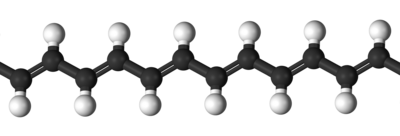Polyacetylene
| Names | |
|---|---|
| IUPAC name
Polyethyne
| |
| Other names
Polyacetylene, PAc
| |
| Identifiers | |
| Properties | |
| [C2H2]n | |
| insoluble | |
| Related compounds | |
Except where otherwise noted, data are given for materials in their standard state (at 25 °C [77 °F], 100 kPa).
| |
Polyacetylene (IUPAC name: polyethyne) is an organic polymer with the repeat unit (C2H2)n. The high electrical conductivity discovered for these polymers in the 1970’s accelerated interest in the use of organic compounds in microelectronics (organic electronics). Polyacetylenes are also known where the H atoms are replaced with alkyl groups.
Structure of polyacetylene
The polymer consists of a long chain of carbon atoms with alternating single and double bonds between them, each with one hydrogen atom. Schematically the structure of polyacetylene is shown below.


One distinguishes trans-polyacetylene, with all double bonds in the trans configuration, from cis-polyactylene, with all double bonds in the cis configuration. Each hydrogen atom could be replaced by a functional group.
Preparation
Acetylene polymerizes in a similar fashion to ethylene: the polymerization can be effected with anionic, cationic, and radical initiators. Polyacetylene is generally not prepared by polymerizing acetylene, which is a highly flammable gas that uncontrollably oligomerizes at high concentrations. The most common syntheses use ring opening metathesis polymerisation ("ROMP") of molecules like cyclooctatetraene and substituted derivatives thereof.[1][2][3]
Conductivity and the Nobel Prize
Highly-conductive polypyrolle and other polyacetylene derivatives were first reported in the early 1960's [4]. Similarly, the 1964 monograph Organic Semiconductors[5] references several reports of high-conductivity oxidized polyacetylenes. Some of these papers apparently report resistivity as low as .001 ohm-cm.
Subsequent rediscovery of the conductive properties of polyacetylene occurred in the early 1970s, when a graduate student of Professor Hideki Shirakawa accidentally polymerized acetylene with 1000 times the required amount of catalyst. The resultant polyacetylene was a silver, conductive film. Shirakawa later collaborated with physicist Alan J. Heeger and chemist Alan G MacDiarmid, and discovered in 1976 that oxidation of this material with iodine results in a 108-fold increase in conductivity. The conductivity of this doped material can approach the conductivity of the best available conductor, silver. While similar highly-conductive polymers had been reported before, this was one of the first known examples of a conductive organic polymer. The three were awarded the Nobel Prize in Chemistry in 2000 for the "For the discovery and development of conductive polymers".[6][7]
References
- ^ Jozefiak, T. H.; Ginsburg, E. J.; Gorman, C. B.; Grubbs, R. H.; Lewis, N. S."Voltammetric Characterization of Soluble Polyacetylene Derivatives Obtained from the Ring-Opening Metathesis Polymerization (ROMP) of Substituted Cyclooctatetraenes" Journal of the American Chemical Society 1993; volume 115, pages 4705-4713. doi:10.1021/ja00064a035
- ^ Gorman, C. B. Ginsburg, E. J.; Grubbs, R. H. "Soluble, Highly Conjugated Derivatives of Polyacetylene from the Ring-Opening Metathesis Polymerization of Monosubstituted Cyclooctatetraenes: Synthesis and the Relationship Between Polymer Structure and Physical Properties" Journal of the American Chemical Society 1993, volume 115, pages 1397-1409. doi:10.1021/ja00057a024
- ^ Langsdorf, Brandi, L.; Zhou, Xin; Lonergan, Mark C., "Kinetic Study of the Ring-Opening Metathesis Polymerization of Ionically Functionalized Cyclooctatetraenes" Macromolecules, 2001, volume 34, pages 2450-2458. doi:10.1021/ma0020685
- ^ "Electronic Conduction in Polymers - Historic Papers".Bolto, BA; McNeill, R; Weiss, DE (1963). "Electronic Conduction in Polymers. III. Electronic Properties of Polypyrrole". Australian Journal of Chemistry. 16: 1090. doi:10.1071/CH9631090.McNeill, R; Weiss, DE; Willis, D (1965). "Electronic conduction in polymers. IV. Polymers from imidazole and pyridine". Australian Journal of Chemistry. 18: 477. doi:10.1071/CH9650477.Bolto, BA; Weiss, DE; Willis, D (1965). "Electronic conduction in polymers. V. Aromatic semiconducting polymers". Australian Journal of Chemistry. 18: 487. doi:10.1071/CH9650487.
- ^ Organic Semiconductors by Yoshikuko Okamoto and Walter Brenner, Reinhold (1964). Chapt.7, Polymers, pp125-158
- ^ Chiang, C. K.; Druy, M. A.; Gau, S. C.; Heeger, A. J.; Louis, E. J.; MacDiarmid, A. G.; Park, Y. W.; Shirakawa, H., "Synthesis of Highly Conducting Films of Derivatives of Polyacetylene, (CH)x," J. Am. Chem. Soc. 1978, 100, 1013-15. doi:10.1021/ja00471a081
- ^ Ebbing, Darrell (2005). General Chemistry (8th ed.). New York: Houghton Mifflin Company. pp. 1042–1043. ISBN 0-618-399410.
{{cite book}}: Unknown parameter|coauthors=ignored (|author=suggested) (help)
